
Website founded by
Milan Velimirović
in 2006
6:09 UTC


| |
MatPlus.Net  Forum Forum  General General  Castling over attacked fields question Castling over attacked fields question |
| |
|
|
|
|
You can only view this page!
| | | (1) Posted by Sarah Hornecker [Monday, Dec 21, 2009 10:34]; edited by Sarah Hornecker [09-12-21] | Castling over attacked fields question
Can a king castle over an attacked field if it wouldn't be attacked if the king was there?
For example:
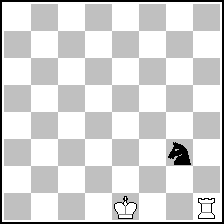 (= 2+1 ) (= 2+1 )
KöKo
Is 1.0-0 possible?
 (= 3+1+1N ) (= 3+1+1N )
Imitator a4
Is 1.0-0 possible?
There's no certain composition I have with that but I'd be interested. Although I remember having one with an imitator on chessproblem.net that was so incorrect that everyone would laugh at it.
| | | (2) Posted by Mihail Croitor [Monday, Dec 21, 2009 11:17] |
as i know, castling at this case is impossible
| | | (3) Posted by Kevin Begley [Monday, Dec 21, 2009 18:20]; edited by Kevin Begley [09-12-21] |
Yes, in both cases, castling is known to be legal.
Win Chloe agrees that castling is legal (in both cases) btw.
Not sure the popeye team has implemented castling rules for such cases.
Edit:
Although there is no codex for fairy rules, the assumption is generally agreed to be resolved as follows:
If the King can step on the intermediate square (d1/f1 for white, d8/f8 for black) w/o a self-check ensuing (resolve checks conditionally, after the King move), then there is no check crossed in castling.
| | | (4) Posted by Thomas Maeder [Monday, Dec 21, 2009 18:54] |
QUOTE
Not sure the popeye team has implemented castling rules for such cases.
begin
pieces white ke1 rh1 black sg2
condition koeko
stipulation ~1
option movenum noboard
end
1.Rh1-g1 !
1.Rh1-h3 !
1.Rh1-h2 !
1.0-0 !
1.Ke1-f1 !
1.Ke1-f2 !
solution finished. Time = 0.000 s
begin
pieces white ke1 rh1 pc2 black se3
condition imitator a4
stipulation ~1
option movenum noboard
end
1.c2-c4[Ia6] !
1.c2-c3[Ia5] !
1.Rh1-h5[Ia8] !
1.Rh1-h4[Ia7] !
1.Rh1-h3[Ia6] !
1.Rh1-h2[Ia5] !
1.0-0[Ia4] !
1.Ke1-f1[Ib4] !
1.Ke1-e2[Ia5] !
1.Ke1-f2[Ib5] !
solution finished. Time = 0.000 s
| | | (5) Posted by Sarah Hornecker [Tuesday, Dec 22, 2009 00:15] |
QUOTE
begin
pieces white ke1 rh1 black sg2
You might want to put the S on g3 - although that also is interesting.
Frohe Weihnachten!
Siegfried
| | | (6) Posted by Thomas Maeder [Tuesday, Dec 22, 2009 18:24] |
QUOTE
You might want to put the S on g3 - although that also is interesting.
Good catch - the output is the same, though.
| | | (7) Posted by Mario Richter [Tuesday, Dec 22, 2009 19:51] |
Kevin wrote: QUOTE
Although there is no codex for fairy rules, the assumption is generally agreed to be resolved as follows:
If the King can step on the intermediate square (d1/f1 for white, d8/f8 for black) w/o a self-check ensuing (resolve checks conditionally, after the King move), then there is no check crossed in castling.
Interestingly, the FIDE rules do not speak of self-check, but only of attack:
QUOTE
3.8b
(2) Castling is prevented temporarily:
a. if the square on which the king stands, or the square which it must cross, or the square
which it is to occupy, is attacked by one or more of the opponent’s pieces ....
The FIDE rules further explain, that castling is not allowed even if the attacking piece is pinned.
So there still are some questions:
(a) 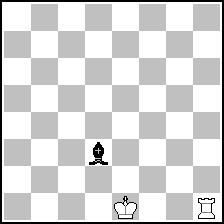 (= 2+1 ) (= 2+1 )
Losing chess.
White to move. 1.0-0 allowed?
(b) 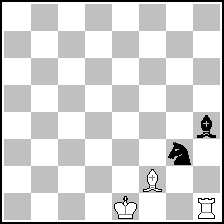 (= 3+2 ) (= 3+2 )
Isardam
White to move. 1.0-0 allowed?
popeye says yes in both cases, so my assumption is, that the popeye team used Kevin's definition - but is this really the right way to implement the legality check for castling?
Best,
mario
| | | (8) Posted by Jacques Rotenberg [Tuesday, Dec 22, 2009 20:01] |
The examples you give seem not difficult :
a) in loosing chess there is no check at all - you can say that the King is not a Kingly piece -
so why the O-O should be forbidden ?
b) in Isardam the Sg3 cannot give check, so Kf1 would be a legal move, so why not O-O ?
| | | (9) Posted by Kevin Begley [Wednesday, Dec 23, 2009 19:20] |
Jacques says:
>a) in loosing chess there is no check at all...
>b) in Isardam the Sg3 cannot give check...
But, Mario's claim is not based upon the word "check."
It presumes that "attack" was deliberately chosen (by FIDE, for the purposes of Fairy Chess) to mean something other than "check."
Needless to say, FIDE's record in rulebook wording falls far short of the genre-spanning, careful consideration that is presumed in such a claim.
The claim itself can be completely dismissed as follows:
1) There is no evidence that the authors of FIDE's rulebook had the intent, or the expertise, to rule upon fairy chess,
2) If there were such evidence, there is no reason to believe their word choice was deliberate (it would contradict their history!),
3) If their word choice was deliberate, there is no evidence that it inherently must produce a different result in the specific problems given, and
4) Ultimately, FIDE is NOT the authoritative body governing Chess Problems, nor the genre of Fairy Chess (notwithstanding the recent attempts to reduce this artform into a corrupted sport for individuals).
My claim is based upon nothing more than my understanding of an "unwritten" Fairy Codex.
In the tragic absence of such a document, I must concede, this is no more than an opinion.
The value of any such opinion depends upon:
1) precedent: problems which make some explicit claim as to the correct interpretation of ambiguous rules, and
2) the interpretation of such problems by "experts" (whether composers, judges, solvers, programmers, players, or enthusiasts).
Furthermore, I should point out that my earlier post contained major oversights:
In the second example given by Siegfried, (wKe1 wRh1 wPc2 bSe3 nIa4), Win Chloe 3.04 does not recognize castling as legal (at least in redaction mode). It should be considered legal, of course -- if 1.Kf1 {Ib4} is legal, as Win Chloe agrees it is, then it cannot be claimed that white passes through "attack" (on f1) when castling.
I intend to make inquiries...
It is possible that Win Chloe incorrectly resolves these intermediate checks prior to considering of the presence of the immitator.
Or, perhaps there really is a controversy here.
In his first example (koko, wKe1 wRh1 bSg3), I completely failed to appreciate the special case...
Since 1.Kf1 is not a legal move (there is nothing adjacent), there could be some question as to whether 1.O-O should be legally permitted. This matter might be resolved by the definitions for koko (for special cases), but even if so, the definition itself might be faulty -- allowing a King to magically step across the void (on f1), when stepping across a check is not possible, might require some leap in logic.
That said, the creator of any fairy condition is entitled only to version 1.0 of the condition.
Beyond that, the rules may be dramatically changed (as often they should be), for the greater benefit of the genre.
Sadly, many fairy conditions have not been carefully inspected, and when legal uncertainties arise, their consumers are naturally inclinded (in the interest of preserving their own works -- whether compositions or software) to defend the status quo (almost whatever the cost).
In the greater interest of the genre, I would propose a series of corrective actions:
1) first preserve previous works,
The governing body needs to support an elaborate version control for fairy elements (online & printable, with clear examples).
All journals should be encouraged to link to such collaborative rules.
The original definition for any fairy element (v1.0) should be provided, along with known alternatives.
Whether these are alternatives, or improvements, is something that will ultimately have to be decided.
This sends a clear signal (all previous works will be preserved) which may reduce the natural inclination to defend absurdity.
2) establish clear philosophical guidelines
Nowhere are clear guidelines more needed than in the special cases (promotion, castling, en passant, two-step pawn moves, check, stalemate, etc).
There must be some pristine philosophical understanding provided as to the underlying workings of each special case.
e.g., exactly why can a pawn make a two step move on the 2nd rank (what about the first rank), and why can they be taken en passant?
3) establish a harmonized form of ideal principles, and sanction fairy elements which conform
Pawns "reborn" onto the 1st rank should treated the same, whether for PWC, Parrain Circe, or Einstein.
Sanctioning is necessary to discourage bad practices (e.g., when GICS-Atomic attempts to contrort the meaning of check, or paralyzing pieces seek to contort game rules).
4) transplant former works into the sanctioned forms
While there certainly is room to show problems in other forms, efforts should be made toward the preferred forms.
5) encourage thematic tourneys which reward early exposure of any ambiguities
There is a long, proud history of problemists forcing changes to the FIDE rulebook.
There is every reason to continue this, to improve our own Fairy Codex.
| | | (10) Posted by Sarah Hornecker [Wednesday, Dec 23, 2009 22:36]; edited by Sarah Hornecker [09-12-23] |
Dear Kevin,
I regard you highly as a friend, but I still must attack you on this:
QUOTE
In his first example (koko, wKe1 wRh1 bSg3), I completely failed to appreciate the special case...
Since 1.Kf1 is not a legal move (there is nothing adjacent), there could be some question as to whether 1.O-O should be legally permitted. This matter might be resolved by the definitions for koko (for special cases), but even if so, the definition itself might be faulty -- allowing a King to magically step across the void (on f1), when stepping across a check is not possible, might require some leap in logic.
We (composers) do agree that the move 1.Rf1 is legal where the white rook steps over the void on g1. So why should the king not be able to step over such a void? In case of castling queenside, the case would be complicated since castling, defined as a king move, would really lead the king to go to a field with nothing around it. So:
 (= 2+1 ) (= 2+1 )
KöKo (without Dead Reckoning*)
Is 1.0-0-0 legal?
In my opinion not - probably everyone disagrees - since c1 really is a void. Of course, if castling were a rook move it would be perfectly legal.
* else the position would be a draw immediately since black is stalemated in the next move
QUOTE
The governing body needs to support an elaborate version control for fairy elements (online & printable, with clear examples).
In fact, we need to explain even the laws of chess. FIDE tends to change rules as they like. I, for one, oppose the change that one can castle only with his own rook and I showed in my problem in MatPlus 31 why. Of course, that's another "obvious rule patch" they made to prevent such problems - there simply is no relevance in practical play since one could not castle with a king in check which always would be the case in such a constellation.
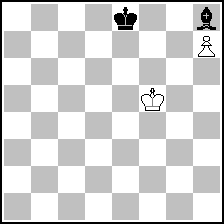 (= 2+2 ) (= 2+2 )
KöKo
FIDE laws before 1993
h#3
MatPlus 31, no. 1097
1.Bg7! h8R! 2.Bf6 Kg6 3.O-O!! Kh7 mate
QUOTE
e.g., exactly why can a pawn make a two step move on the 2nd rank (what about the first rank), and why can they be taken en passant?
That's why certain fairy conditions don't allow pawns on the first rank - they don't know if pawns would be able to move one step, three steps or not at all.
| | | (11) Posted by Ian Shanahan [Thursday, Dec 24, 2009 09:20] |
Here's another one:
White Ke1, Neutral Rh1 - Monochrome Chess. 1.0-0?
I say 'Yes': although f1 is "attacked", the wK could never arrive there under Monochrome rules.
Thoughts?
PS: good on you, Kevin. We think alike about establishing Fairy-Chess protocols...
| | | (12) Posted by Joost de Heer [Thursday, Dec 24, 2009 10:32] |
Last week I posed a similar question on the retros list:
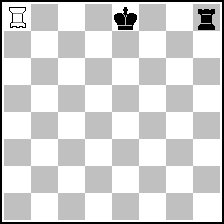 (= 1+2 ) (= 1+2 )
Alice chess (Ra8 on board B)
Is castling legal?
Someone who uses the 'the single king-move must be legal' method will decide that it's illegal to castle.
| | | (13) Posted by Kevin Begley [Thursday, Dec 24, 2009 11:19]; edited by Kevin Begley [09-12-24] |
Siegfried,
You make a very good point.
Leaping across voids appears to be an inherent part of the koko condition, and as such, castling across a void may be the best interpretation.
But, if so, the philosophy of castling is more complicated -- the algorithm to determine intermediary checks reqruires more than checking the legality of the first King step.
A clear algorithm is required to describe castling rights in fairies, which does not resort to special cases (like Koko).
Perhaps the following is sufficient:
Castling is legal only if all of the following conditions are met:
a) there is no specific or retrograde evidence that either the King or the Rook have moved to violate castling rights,
b) the King is not under attack (in check),
c) either the King has no opportunity to step onto the intermediate square, or doing so does not result in attack (self-check),
d) after King and Rook have reached their final castling position, the King is not under attack (self-check).
I'm guessing it is actually much more complicated...
For example, part a) may reqruire careful wording, to allow for rebirths for circe forms.
And, it is possible that c) results in other conflicts (it may lead to strange Haan questions, for example).
This is why some conditions might be better left unsanctioned (perhaps Koko is such a condition).
Also, there may be additional castling options on Vertical Cylinder boards (there have been many disagreements about this!), and composers who rely upon specific definitions (or software implementations) may suffer unexpected cook claims!
If these are legal, as I suspect they are, then there are additional intermediate squares to consider, when assessing castling rights (also true in the Rookagogo condition).
The longer we wait to get this right, the more difficult it becomes to find a valid description of special cases.
@Joost,
Clearly, castling should be illegal in the Alice example.
1...Kf1(b) is a move which is clearly only illegal due to self-check.
I am no expert on the Alice condition...
In fact, it is quite possible that this was defined to be legal.
It would be a very poor condition, in my view, if so defined.
If anyone disagrees, please provide your general algorithm to resolve the matter of castling across check in fairies...
Please note, any algorithm, which defers authority to the specific rules of the given fairy element, may become unstable when fairy elements are combined (perhaps combinations are overused anyway). As such, this fails to provide a general algorithm.
| | | (14) Posted by Kevin Begley [Thursday, Dec 24, 2009 12:09]; edited by Kevin Begley [09-12-24] |
@ Siegfried,
>In fact, we need to explain even the laws of chess. FIDE tends to change rules as they like.
Here, you are well off your mark...
FIDE changes the wording of rules (not the rules), as they deem necessary (not "as they like") to accurately describe the game, as they are charged to do.
Back in the 1950s, a highly creative baseball player stood on second base, just 1 shy of some stolen base record.
The problem: his teammate occupied 3rd base.
His solution was to steal first base (from second)!
The umpires could find no specific rule to call him out, but regardless, they called him out anyway.
The next year, the wording of the rulebook was changed, so players could be called out for running anything but counter-clockwise.
We can probably agree that the umprires were wrong to call the player out, at the time.
But, clearly the rulebook had to change, to remove any future ambiguity.
We may also disagree as to whether the rules should allow/disallow stealing 1st base, but this only leads us off-topic -- the point remains: some authority is charged to make such decisions, and update the rulebook accordingly (and hear appeals).
FIDE has done a fairly good job of making changes (and watching out for clever problemists, who were quick to steal first base).
Unfortunately, problemists live in glass houses.
We have no fairy rulebook, we have no general philosophy of rules, and we have no authority in place to make rulings (where we might disagree).
Meanwhile, we continue to throw stones at old (long since updated) versions of the FIDE rulebook.
>I, for one, oppose the change that one can castle only with his own rook...
Your opinion is noted, but hardly relevant to FIDE (in the making of their rulebook).
FIDE writes their rule book for the orthodox game (not for koko helpmates), and we are bound to their wording (or charged to write our own book).
Your propblem is quite interesting, but of course, such problems are much better when the present rulebook is employed.
@ Ian,
Yet another excellent example!
Currently, my best guess would be that it should be legal to castle short with a neutral rook in monochrome chess.
This is based upon my updated algorithm (see above), which does not resolve self-checks on specific intermediate squares unless those squares are actually "reachable."
| | | (15) Posted by Joost de Heer [Thursday, Dec 24, 2009 13:06] |
QUOTE
@Joost,
Clearly, castling should be illegal in the Alice example.
1...Kf8(b) is a move which is clearly only illegal due to self-check.
I am no expert on the Alice condition...
In fact, it is quite possible that this was defined to be legal.
It would be a very poor condition, in my view, if so defined.
The problem with the Alice example is that legality of moves is only considered on the board that the move is played on. The pieces are moved to the second board after finishing the move on the first. While castling, black doesn't pass a guarded square, because guarding is only considered on board A, the board the move is played on. Similar to the 'no pieces must be between king and rook' situation for queenside castling: There may be a piece on board B on b8, and black can still castle on board A, because on that board there are no pieces between the king and rook.
Paul Raican sent me a good description of Alice: http://www.chessvariants.org/other.dir/alice.html
| | | (16) Posted by Sarah Hornecker [Thursday, Dec 24, 2009 13:36] |
QUOTE
FIDE changes the wording of rules (not the rules), as they deem necessary (not "as they like") to accurately describe the game, as they are charged to do.
Yes, but most of these are obvious rule patches. It might have started earlier but the most notable example is the inability to castle with a newly promoted rook, after Max Pam and Tim Krabbé published their famous problem.
Of course not all rule changes are bad for us: For example to allow stalemate only to end the game if the last move was legal - this could have lead to one-move stalemates from the beginning of the game if properly abused.
Cya around,
Siegfried
| | | (17) Posted by Kevin Begley [Thursday, Dec 24, 2009 18:11]; edited by Kevin Begley [09-12-24] |
Joost,
In general, I am no fan of the pages you link to... however, in this case, the Alice example is excellent.
You said:
>The problem with the Alice example is that legality of moves is only considered on the board that the move is played on.
Not really true. The destination squares (on the other board) must be unoccupied, and you cannot move into self-check.
So, legality of moves does depend upon both boards.
Furthermore, if castling was legal in the original Alice (it must certainly be assumed to have been, from the definitions given), then so too must there be an assesment of checks on intermediary squares!
The question is: upon which board should such an assesment be made?
Actually, this question becomes clouded, because there are really two questions we might try to answer:
1) can we divine somehow what might have been the original intent?
2) what is the best way to resolve the matter today?
I have no interest in arguing the former question -- the answer seems to depend mostly upon the level of foresight one is willing to credit (by presumption) the inventor.
The answer to the second question is important; and, for me, the answer is clear.
To resolve whether the King can step onto an intermediate castling square, there is no better resolution than actually performing the move.
If you'll permit a slight modifcation to your example...
bKe8(A), bRh8(A), wRf1(A): 1...Kf8 is reachable, but illegal (self-check on board A), thus 1...O-O is illegal.
bKe8(A), bRh8(A), wRf1(B): 1...Kf8 is reachable, but illegal (self-check on board B), thus 1...O-O is illegal.
Thus, attacks upon intermediate squares of either board should prevent castling.
Aside: I have no problem with long castling should some benign unit occupy b1/b8.
The resolution of en passant, in Alice, is far more difficult, in my view.
@Siegfried,
You said:
>For example to allow stalemate only to end the game if the last move was legal - this could have lead to one-move stalemates from the beginning of the game if properly abused.
I don't follow how you intend to abuse the rulebook wording here... perhaps you can rephrase (preferably with an example problem).
| | | (18) Posted by Joost de Heer [Thursday, Dec 24, 2009 20:05] |
QUOTE
the most notable example is the inability to castle with a newly promoted rook
Incorrect. Even in '72, the wording of the castling rule had 'two neighbouring squares' and 'on the same file'. Pam/Krabbé intentionally left out that part of the rule when publishing their composition.
For those who can read Dutch, here's the PS from chapter 7 in 'Schaakcuriosa' (page 126), where Krabbé explains this:
QUOTE
Naschrift:
Zoals nu weer op bladzijde 112 zo stond dit verhaal over de ellenlange rokade in Schaakbulletin 52/53, in april 1972. Nu, in 1974, durf ik wel toe te geven dat ik u geflest heb; expres citeerde ik de spelregels verkeerd om die rokade mogelijk te maken. Dat is hij niet. Er staat namelijk: "De koning wordt van zijn oorspronkelijke veld verplaatst naar een van de <i>twee</i> naastbijgelegen velden van dezelfde kleur <i>op dezelfde rij</i>'. De gekursiveerde gedeelten had ik weggelaten maar er waren, zoals ik ook verwacht had, verschillende lezers die mij op deze 'vergissing' attendeerden. Wie er ook in vloog was de schaakrubricist van het Belgische blad 'Volksgazet'. Een prachtige rubriek overigens, drie-en-halve kolom lang in kleine lettertjes, dat hebben we hier niet. Het grootste gedeelte daarvan was op 6-6-1972 besteed aan de rokade, naar aanleiding van mijn artikel in SB 52/53. '...steekt de Nederlandse analyticus Tim Krabbé de draak met de definitie van de rochademanoeuvre, zoals uitgedrukt in de officiële tekst van de FIDE.'
Ik maak mij verontschuldigingen: ik heb bewust verkeerd geciteerd, een beschamend vergrijp voor een journalist. Maar ik vond het zo leuk!
  |
| | | (19) Posted by Sarah Hornecker [Friday, Dec 25, 2009 01:17]; edited by Sarah Hornecker [09-12-25] |
QUOTE
@Siegfried,
You said:
>For example to allow stalemate only to end the game if the last move was legal - this could have lead to one-move stalemates from the beginning of the game if properly abused.
I don't follow how you intend to abuse the rulebook wording here... perhaps you can rephrase (preferably with an example problem).
Today:
QUOTE
5.2
a.
The game is drawn when the player to move has no legal move and his king is not in check. The game is said to end in ‘stalemate’. This immediately ends the game, provided that the move producing the stalemate position was legal.
Earlier:
QUOTE
The game is drawn when the king of the player who has the move is NOT in check, and this player cannot make any legal move. The player's king is then said to be "stalemated". This immediately ends the game. and:
QUOTE
If, during a game, it is found that an illegal move was made, the position shall be reinstated to what it was before the illegal move was made. The game shall then continue by applying the rules of Article 7 to the move replacing the illegal move.
(My highlighting)
And here's an extreme example.
So after 1.e4 e5 2.Bc4 Sf6 one can play the unbelievable:
3.Qd1-d6!!, capturing Ra8, Sb8, Bc8, Qd8, Bf8, Sf6, Rh8, Pa7, Pb7, Pc7, Pd7, Pe5, Pf7, Pg7 and Ph7 en passant. Thus black is stalemated and the game is immediately ended as a draw. Black can't protest against this since illegal moves can only be taken back during a game.
That's why the move leading to stalemate now ends the game only if it is legal. An obvious rule patch since it should be obvious to everyone how the rule was intended to be - but it was formulated in a bad way. As far as I know, most obvious rule patches were made for Dungeons & Dragons and collection card games.
Another one from chess:
QUOTE
And speaking of pawn promotion, that's another rule which is now specified very carefully to avoid certain abuses — such as remaining a pawn or promoting to an enemy piece. Yes, there are positions where those options are good, although it's vanishingly unlikely that they'd ever occur. See here for an example of when promoting to an enemy piece is more beneficial. (with here linked to http://en.wikipedia.org/wiki/Joke_chess_problem#Offbeat_interpretations_of_the_rules_of_chess)
And one of my favorite examples on how to abuse rules, although from programming instead of chess: QUOTE
The International Obfuscated C Code Contest added a rule in 1995 that required all submissions to have source code at least one byte in length. Why? In 1994, "the world's smallest self-replicating program" won an award for "Worst Abuse of the Rules" by being zero bytes in size.
Both taken from http://tvtropes.org/pmwiki/pmwiki.php/Main/ObviousRulePatch
There was a brilliant joke tourney around 1993 that had some curios examples, the first prize winner being a Sherlock Holmes story with 2x2 helpmates occuring by the different naming of pieces in different languages (for example, P being "pawn" and "paard", thus making two helpmates). I think it was the Klüver tourney. There was a problem with a rather unusual interpretation of how a bishop could move, thus creating a very unusual Indian.
| |
No more posts |
MatPlus.Net  Forum Forum  General General  Castling over attacked fields question Castling over attacked fields question |
|
|
|
 ISC 2025
ISC 2025 Forum
Forum  General
General  Castling over attacked fields question
Castling over attacked fields question 


